Tipu Sultan: a group of eighteen editions of the British newspaper, the Northampton Mercury, reporting on events relating to Haider 'Ali, Seringapatam and Tipu Sultan
Northampton, between march 1799 and 0ctober 1800consisting of eighteen editions of the Northampton Mercury, 16th March 1799-11th October 1800, each edition consisting of two conjoined leaves, four sides of text
500 x 350 mm. and slightly smaller(18)FootnotesThe groups of newspapers in this lot and the one following (lots 99 and 99A) provide an almost weekly record, from a British point of view - and allowing for the sheer length of time it took for news to reach Britain from India - of one of the defining struggles between the East India Company and its main enemy in the south of the country for almost two decades: Tipu Sultan, ruler of Mysore, and his father, Haider Ali.
Amid the reports of military and political developments in other parts of the world - these were certainly 'interesting times' - and the curious adverts for patent medicine and local estate sales, as well as accounts of dreadful robberies and other outrages, we can follow the story, from the early news of the death of Haider Ali, the apparent weakness of Tipu, then growing concern over his strength, the ever-present issue of what the French were doing in South India; then outright war with Tipu ending, of course, with the capture of Seringapatam, and the fascination with the gory details of the slaughter, but even more with the amounts of treasure seized. The obsession with prize-money (and money in general) is a thread running through these papers - and contemporary British history.
The details of the editions are as follows (in chronological order):
The Northampton Mercury, 16th March 1799: 'It is certain that this country has now nothing to fear from Tippoo Saib' [!] He assured the British that he was not in league with the French and 'has offered to possess the British Government in India of the important Post of Mangalore, which, in the event of the success of Buonaparte, was the great object the French aimed at, p. 1, col. 1.
The Northampton Mercury, 8th June 1799: 'The advices received by the last overland dispatch from India, corroborate the information of the probability of a war between the British Government and Tippoo Saib. The army in India has already taken the field [...] Tippoo Saib has been informed, that unless he gives up all the sepoys that have entered his service, a war will be commenced against him with the utmost vigour', p. 2, col. 2.
The Northampton Mercury, 27th July 1799: 'On Friday a letter was received from Bombay, that hostilities have actually commenced'; this has not been confirmed, but 'we lay it before our readers without presuming to vouch for its accuracy'. The letter (of 1st March) is quoted in part - 'Our armies are already marching towards Seringapatam', p. 1, col. 2.
The Northampton Mercury, 3rd August 1799: 'Official Accounts have been received at the East-India House, of the complete Defeat of Tippoo, and of his having been forced to retreat to Seringapatam, with great loss [...] So complete was the overthrow of Tippoo, that it is supposed that the East-India Company will depose him', p. 3, col. 3.
The Northampton Mercury, 10th August 1799: further accounts of the defeat of 6th March: 'the victory was brilliant and complete. It was attended with great loss in the field to the perfidious Prince who provoked our arms, and in its consequences may involve his fall from a Throne which he has held, since the Peace of Seringapatam, by the forbearance and generosity of Great Britain', p. 1, col. 1.
The Northampton Mercury, 17th August 1799: much of the first column on the front page is given over to a detailed account of the battle. It concludes: 'It appears that Tippoo, in the late action, must have had some very experienced leaders who knew the ground well; for they were concealed in a thick jungle, and made a very unexpected attack on the rear of our line. The grape shot and musquetry which the enemy were exposed to was past description; and they retreated into the jungle in the greatest disorder', p. 1, col. 1.
The Northampton Mercury, 14th September 1799: the news of the siege is placed in a section called 'Postscript', though it is in fact one of the longer articles (entitled Death of Tippoo Saib, and the Capture of Seringapatam, the Capital of his Empire).
This morning arrived at the India-House from Plymouth, the Purser of the Barwell East-Indiaman; by which ship we have the important Intelligence, that on the 4th of May the British Forces under General Stuart, took SERINGAPATAM, Tippoo's Capital, by Assault, with a very trifling Loss on the part of the British Troops. The Body of TIPPOO was found among the slain upon the ramparts of the place, and his two SONS were taken in his Palace.
By the Death of this restless Tyrant, and the overthrow of his Empire, the lawful King of Mysore will be restored to his Throne, the English power in India effectually secured, and the hopes of the French in that quarter completely destroyed.
Private Letters mention that immense Treasure has been taken in Seringapatam.
There follows a copy of a letter from the Madras Gazette, from Lt. Gen. Harris to the Governor-General, recounting the assault in great detail, and ending with the death of Tipu and the surrender of Seringapatam, p. 3, col. 3 & 4.
The Northampton Mercury, 21st September 1799: a short piece based on a despatch from General Harris, describing the results of the victory: 'The successful termination of the war in India secures to us the sovereignty of that country' [...] 'the treasure found in Seringapatam has been variously stated: some accounts estimate it at three, others at thirteen millions. During a long series of years, Tippoo and his father plundered the East, and here were their riches deposited' [...] 'the resources which will flow into the Company's Treasury are at present incalculable', p. 1, col. 2.
The Northampton Mercury, 5th October 1799: the text of a letter from Tipu to the French Directory - 'I may be able to attack and to destroy for ever our common Enemy'. The article notes woundedly that at the time he 'was sending Vakeels to the British Government, expressive of his friendship in the strongest terms', p. 3, col. 1.
The Northampton Mercury, 26th October 1799: a short note, based on a despatch from Madras of 6th June, reporting that Tipu's army was dispersed and that Mysore was generally calm, p. 2, col. 2.
The Northampton Mercury, 14th December 1799: a long article relating that Raja Oodiaver has been returned to the throne of Mysore; of the Treaty of Partition of the region into four parts ('the first of these, which includes Seringapatam, has been the recompence to the East-India Company for the expences which it has incurred in the War'); that Tipu's sons are to reside at Vellore; and the division of the spoils.
The first division of the Prize-money taken at Seringapatam, distributed among the gallant Captors, amounted to one million sterling [...] The Star and jewel, with the other ornaments worn by Tippoo, have been presented by the army to Lord Mornington; his War Turban and his Sword are very properly to be made a present of to Lord Cornwallis; and his Library to the Directors of the East-India Company. [...] The Sultaun's Throne being too unwieldy to be carried, had been broken up [a description follows]; It was valued at 60,000 pagodas. After further description of the throne and its immense value: 'A number of tygers were found in the Palace yard, which were ordered to be shot for fear of accidents'. Before looting the Seraglio, or harem, permission was sought and the women were politely removed first; however, the officers 'were disappointed in every respect; for they did not find anything of value, and instead of elegant habitations which they imagined, found places as filthy as the lowest and dirtiest dwelling in the Bazar, the furniture consisting of a chair, a swing, two or three boxes of clothes, a miserable bed, and a shelf of perfumes, spices, &c.', p. 2, col. 1.
The Northampton Mercury, 1st February 1800: further details which had been learned of the final assault and death of Tipu, including the well-known story of his death when already badly wounded: 'A servant, who has survived, relates, that one of the soldiers seized the Sultaun's sword-belt (which was very rich) and attempted to pull it off; that the Sultaun, who still held his sword in his hand, made a cut at him with all his remaining strength, and wounded him about the knee, on which he put his piece to his shoulder, and shot the Sultaun through the temple, when he instantly expired', p. 4, col. 1 & 2.
The Northampton Mercury, 15th February 1800: the first distribution of the prize money from Seringapatam - the Commander in Chief received the equivalent of £120,000; subalterns, £430 each, p. 2, col. 2.
The Northampton Mercury, 26th April 1800: extracts from a letter from an officer serving at Seringapatam. Tipu had the capacity to inflict a great defeat on the British; however, 'It had been for some time reported, that Tippoo was become subject to fits of mental derangement, and the whole of his conduct seems to justify that opinion'. Despite this, much could have easily gone wrong, and 'notwithstanding the errors committed by the Sultan in defence of the place, nothing less than the vast combined army in our service could have carried the enterprize with success'. There follow more specific details of the final assault, including a description of Tipu's personal jewellery: 'It was said that he constantly wore a ruby ring, which was esteemed by him as the most valuable in his treasury; his turban also was always adorned with a jewel of great value; and a pearl rosary was a continual ornament of his person [...] Neither of these precious articles have appeared since the Sultan's death [...] His body was found late in the evening beneath a heap of others, brought together in one promiscuous slaughter. He had been shot in the temples, and was otherwise wounded as it appeared with a bayonet'. The account ends with details of the slaughter and plundering.
Lastly there is a separate note about the famous 'Musical Tyger' - 'a sufficient proof (if any yet were wanting) of the deep hate and extreme loathing of Tippoo Saib towards the English nation' - with a description of the wooden model of a tiger on top of a European officer (now in the Victoria and Albert Museum): 'This machine has been sent from Madras to the Chairman of the East India Company, in one of the homeward ships, in order that it may be presented to his Majesty', p. 4, col. 1 & 2.
The Northampton Mercury, 14th June 1800: relating the discovery that Tipu had planned to send a fresh mission to enlist French aid, and intended to present members of the Directory with jewels (which were not in fact sent). 'One million sterling is now calculated to be the amount of the Seringapatam prize-money', p. 2, col. 2.
The Northampton Mercury, 26th July 1800: 'Cause of the Ruin of Tippoo' - namely, taking the side of the French Republic (after an apparently minor incident, a French naval officer encouraging the Sultan), p. 1, col. 1.
The Northampton Mercury, 2nd August 1800: 'A girdle of gold, three feet in length, two inches broad, and a quarter of an inch thick, formed of plates of singularly fine workmanship, perfectly elastic, joined in front by a clasp of gold, which weighed 20 ounces, and supposed to have been worn by the late Tippoo Sultaun, was a few days since left at an assayer's in the city to be melted', p. 1, col. 2.
The Northampton Mercury, 11th October 1800: plunder from Seringapatam, intended as presents for the Royal Family, were exhibited that week at India House, the 'most remarkable' of which were: 'A Green War Dress [...] called a Chetta [...] The Turban has been dipped in the waters of the fountain of Zum Zum at Mecca, and is hence supposed to be invulnerable. [etc.] 'This is intended for the Duke of York'. 'A Piece of Mechanism, representing a Tiger in the act of devouring a prostrate European [...] The machinery is so contrived, that while the organ is playing, the hand of the European is often lifted up to express his helpless condition'. 'Tyger's Head', from Tipu's throne, 'accompanied by a rich a beautiful carpet'. 'The Bedding of the Sultaun [...] one peitre or cuirass to cover the body. These are presents to the King'. 'The Red War Dress falls to the share of the Prince of Wales. This dress was worn by Tippoo in his campaign, in 1786, against the Nizam and Mahrattas. He was then in the plenitude of his power', p. 2, col. 2.
Tipu Sultan: a group of eighteen editions of the British newspaper, the Northampton Mercury, reporting on events relating to Haider 'Ali, Seringapatam and Tipu Sultan
Northampton, between march 1799 and 0ctober 1800consisting of eighteen editions of the Northampton Mercury, 16th March 1799-11th October 1800, each edition consisting of two conjoined leaves, four sides of text
500 x 350 mm. and slightly smaller(18)FootnotesThe groups of newspapers in this lot and the one following (lots 99 and 99A) provide an almost weekly record, from a British point of view - and allowing for the sheer length of time it took for news to reach Britain from India - of one of the defining struggles between the East India Company and its main enemy in the south of the country for almost two decades: Tipu Sultan, ruler of Mysore, and his father, Haider Ali.
Amid the reports of military and political developments in other parts of the world - these were certainly 'interesting times' - and the curious adverts for patent medicine and local estate sales, as well as accounts of dreadful robberies and other outrages, we can follow the story, from the early news of the death of Haider Ali, the apparent weakness of Tipu, then growing concern over his strength, the ever-present issue of what the French were doing in South India; then outright war with Tipu ending, of course, with the capture of Seringapatam, and the fascination with the gory details of the slaughter, but even more with the amounts of treasure seized. The obsession with prize-money (and money in general) is a thread running through these papers - and contemporary British history.
The details of the editions are as follows (in chronological order):
The Northampton Mercury, 16th March 1799: 'It is certain that this country has now nothing to fear from Tippoo Saib' [!] He assured the British that he was not in league with the French and 'has offered to possess the British Government in India of the important Post of Mangalore, which, in the event of the success of Buonaparte, was the great object the French aimed at, p. 1, col. 1.
The Northampton Mercury, 8th June 1799: 'The advices received by the last overland dispatch from India, corroborate the information of the probability of a war between the British Government and Tippoo Saib. The army in India has already taken the field [...] Tippoo Saib has been informed, that unless he gives up all the sepoys that have entered his service, a war will be commenced against him with the utmost vigour', p. 2, col. 2.
The Northampton Mercury, 27th July 1799: 'On Friday a letter was received from Bombay, that hostilities have actually commenced'; this has not been confirmed, but 'we lay it before our readers without presuming to vouch for its accuracy'. The letter (of 1st March) is quoted in part - 'Our armies are already marching towards Seringapatam', p. 1, col. 2.
The Northampton Mercury, 3rd August 1799: 'Official Accounts have been received at the East-India House, of the complete Defeat of Tippoo, and of his having been forced to retreat to Seringapatam, with great loss [...] So complete was the overthrow of Tippoo, that it is supposed that the East-India Company will depose him', p. 3, col. 3.
The Northampton Mercury, 10th August 1799: further accounts of the defeat of 6th March: 'the victory was brilliant and complete. It was attended with great loss in the field to the perfidious Prince who provoked our arms, and in its consequences may involve his fall from a Throne which he has held, since the Peace of Seringapatam, by the forbearance and generosity of Great Britain', p. 1, col. 1.
The Northampton Mercury, 17th August 1799: much of the first column on the front page is given over to a detailed account of the battle. It concludes: 'It appears that Tippoo, in the late action, must have had some very experienced leaders who knew the ground well; for they were concealed in a thick jungle, and made a very unexpected attack on the rear of our line. The grape shot and musquetry which the enemy were exposed to was past description; and they retreated into the jungle in the greatest disorder', p. 1, col. 1.
The Northampton Mercury, 14th September 1799: the news of the siege is placed in a section called 'Postscript', though it is in fact one of the longer articles (entitled Death of Tippoo Saib, and the Capture of Seringapatam, the Capital of his Empire).
This morning arrived at the India-House from Plymouth, the Purser of the Barwell East-Indiaman; by which ship we have the important Intelligence, that on the 4th of May the British Forces under General Stuart, took SERINGAPATAM, Tippoo's Capital, by Assault, with a very trifling Loss on the part of the British Troops. The Body of TIPPOO was found among the slain upon the ramparts of the place, and his two SONS were taken in his Palace.
By the Death of this restless Tyrant, and the overthrow of his Empire, the lawful King of Mysore will be restored to his Throne, the English power in India effectually secured, and the hopes of the French in that quarter completely destroyed.
Private Letters mention that immense Treasure has been taken in Seringapatam.
There follows a copy of a letter from the Madras Gazette, from Lt. Gen. Harris to the Governor-General, recounting the assault in great detail, and ending with the death of Tipu and the surrender of Seringapatam, p. 3, col. 3 & 4.
The Northampton Mercury, 21st September 1799: a short piece based on a despatch from General Harris, describing the results of the victory: 'The successful termination of the war in India secures to us the sovereignty of that country' [...] 'the treasure found in Seringapatam has been variously stated: some accounts estimate it at three, others at thirteen millions. During a long series of years, Tippoo and his father plundered the East, and here were their riches deposited' [...] 'the resources which will flow into the Company's Treasury are at present incalculable', p. 1, col. 2.
The Northampton Mercury, 5th October 1799: the text of a letter from Tipu to the French Directory - 'I may be able to attack and to destroy for ever our common Enemy'. The article notes woundedly that at the time he 'was sending Vakeels to the British Government, expressive of his friendship in the strongest terms', p. 3, col. 1.
The Northampton Mercury, 26th October 1799: a short note, based on a despatch from Madras of 6th June, reporting that Tipu's army was dispersed and that Mysore was generally calm, p. 2, col. 2.
The Northampton Mercury, 14th December 1799: a long article relating that Raja Oodiaver has been returned to the throne of Mysore; of the Treaty of Partition of the region into four parts ('the first of these, which includes Seringapatam, has been the recompence to the East-India Company for the expences which it has incurred in the War'); that Tipu's sons are to reside at Vellore; and the division of the spoils.
The first division of the Prize-money taken at Seringapatam, distributed among the gallant Captors, amounted to one million sterling [...] The Star and jewel, with the other ornaments worn by Tippoo, have been presented by the army to Lord Mornington; his War Turban and his Sword are very properly to be made a present of to Lord Cornwallis; and his Library to the Directors of the East-India Company. [...] The Sultaun's Throne being too unwieldy to be carried, had been broken up [a description follows]; It was valued at 60,000 pagodas. After further description of the throne and its immense value: 'A number of tygers were found in the Palace yard, which were ordered to be shot for fear of accidents'. Before looting the Seraglio, or harem, permission was sought and the women were politely removed first; however, the officers 'were disappointed in every respect; for they did not find anything of value, and instead of elegant habitations which they imagined, found places as filthy as the lowest and dirtiest dwelling in the Bazar, the furniture consisting of a chair, a swing, two or three boxes of clothes, a miserable bed, and a shelf of perfumes, spices, &c.', p. 2, col. 1.
The Northampton Mercury, 1st February 1800: further details which had been learned of the final assault and death of Tipu, including the well-known story of his death when already badly wounded: 'A servant, who has survived, relates, that one of the soldiers seized the Sultaun's sword-belt (which was very rich) and attempted to pull it off; that the Sultaun, who still held his sword in his hand, made a cut at him with all his remaining strength, and wounded him about the knee, on which he put his piece to his shoulder, and shot the Sultaun through the temple, when he instantly expired', p. 4, col. 1 & 2.
The Northampton Mercury, 15th February 1800: the first distribution of the prize money from Seringapatam - the Commander in Chief received the equivalent of £120,000; subalterns, £430 each, p. 2, col. 2.
The Northampton Mercury, 26th April 1800: extracts from a letter from an officer serving at Seringapatam. Tipu had the capacity to inflict a great defeat on the British; however, 'It had been for some time reported, that Tippoo was become subject to fits of mental derangement, and the whole of his conduct seems to justify that opinion'. Despite this, much could have easily gone wrong, and 'notwithstanding the errors committed by the Sultan in defence of the place, nothing less than the vast combined army in our service could have carried the enterprize with success'. There follow more specific details of the final assault, including a description of Tipu's personal jewellery: 'It was said that he constantly wore a ruby ring, which was esteemed by him as the most valuable in his treasury; his turban also was always adorned with a jewel of great value; and a pearl rosary was a continual ornament of his person [...] Neither of these precious articles have appeared since the Sultan's death [...] His body was found late in the evening beneath a heap of others, brought together in one promiscuous slaughter. He had been shot in the temples, and was otherwise wounded as it appeared with a bayonet'. The account ends with details of the slaughter and plundering.
Lastly there is a separate note about the famous 'Musical Tyger' - 'a sufficient proof (if any yet were wanting) of the deep hate and extreme loathing of Tippoo Saib towards the English nation' - with a description of the wooden model of a tiger on top of a European officer (now in the Victoria and Albert Museum): 'This machine has been sent from Madras to the Chairman of the East India Company, in one of the homeward ships, in order that it may be presented to his Majesty', p. 4, col. 1 & 2.
The Northampton Mercury, 14th June 1800: relating the discovery that Tipu had planned to send a fresh mission to enlist French aid, and intended to present members of the Directory with jewels (which were not in fact sent). 'One million sterling is now calculated to be the amount of the Seringapatam prize-money', p. 2, col. 2.
The Northampton Mercury, 26th July 1800: 'Cause of the Ruin of Tippoo' - namely, taking the side of the French Republic (after an apparently minor incident, a French naval officer encouraging the Sultan), p. 1, col. 1.
The Northampton Mercury, 2nd August 1800: 'A girdle of gold, three feet in length, two inches broad, and a quarter of an inch thick, formed of plates of singularly fine workmanship, perfectly elastic, joined in front by a clasp of gold, which weighed 20 ounces, and supposed to have been worn by the late Tippoo Sultaun, was a few days since left at an assayer's in the city to be melted', p. 1, col. 2.
The Northampton Mercury, 11th October 1800: plunder from Seringapatam, intended as presents for the Royal Family, were exhibited that week at India House, the 'most remarkable' of which were: 'A Green War Dress [...] called a Chetta [...] The Turban has been dipped in the waters of the fountain of Zum Zum at Mecca, and is hence supposed to be invulnerable. [etc.] 'This is intended for the Duke of York'. 'A Piece of Mechanism, representing a Tiger in the act of devouring a prostrate European [...] The machinery is so contrived, that while the organ is playing, the hand of the European is often lifted up to express his helpless condition'. 'Tyger's Head', from Tipu's throne, 'accompanied by a rich a beautiful carpet'. 'The Bedding of the Sultaun [...] one peitre or cuirass to cover the body. These are presents to the King'. 'The Red War Dress falls to the share of the Prince of Wales. This dress was worn by Tippoo in his campaign, in 1786, against the Nizam and Mahrattas. He was then in the plenitude of his power', p. 2, col. 2.
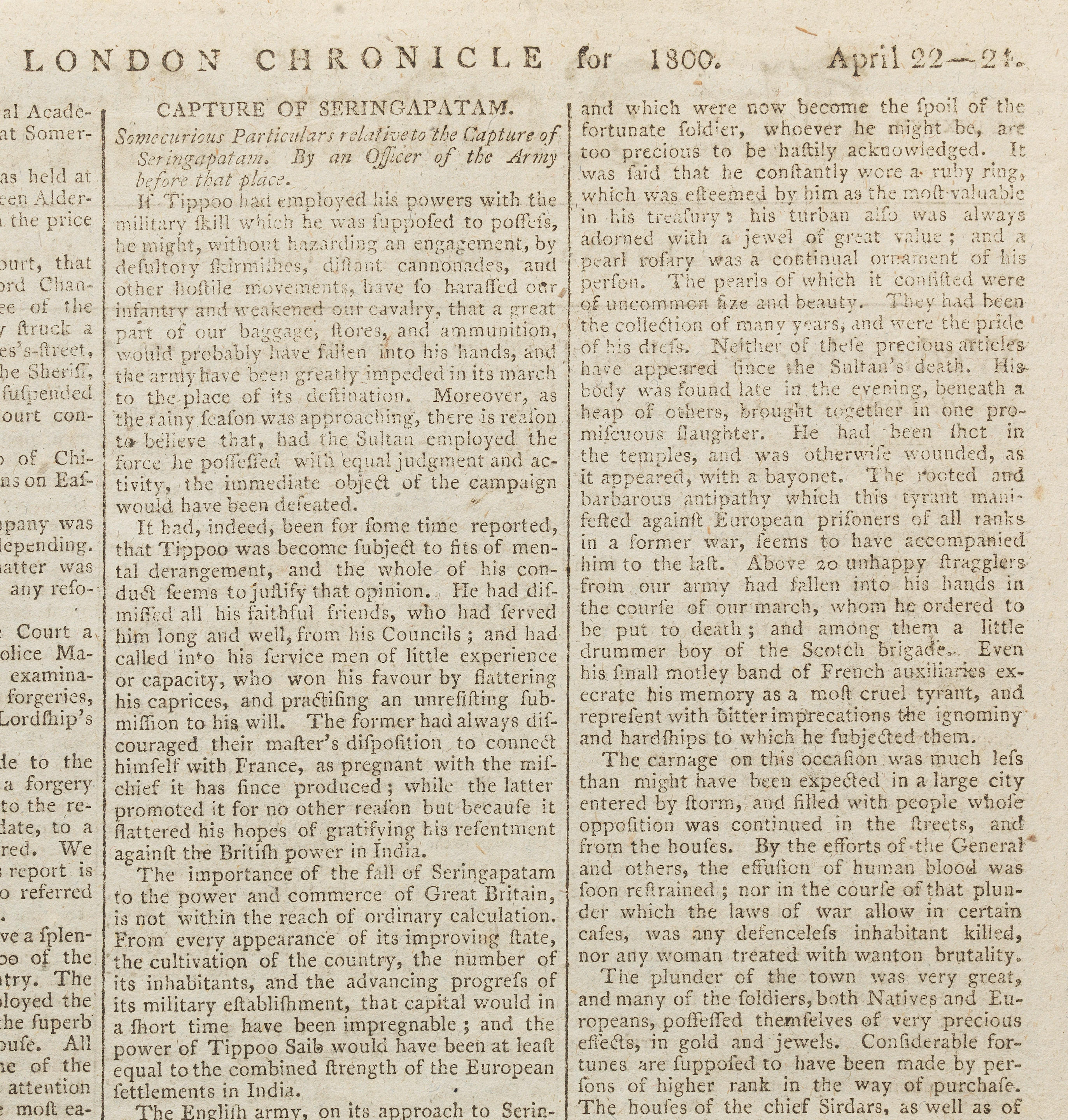

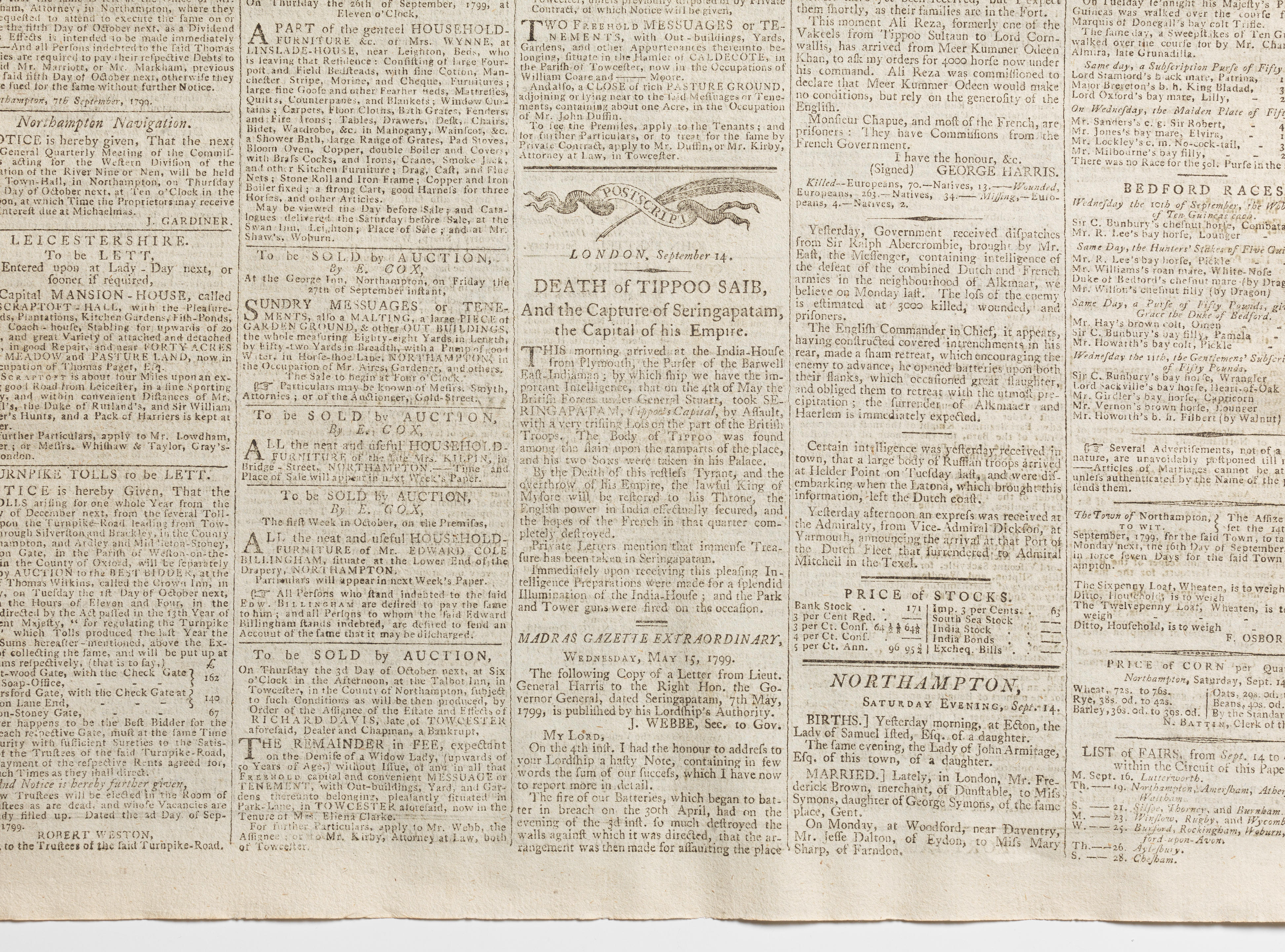

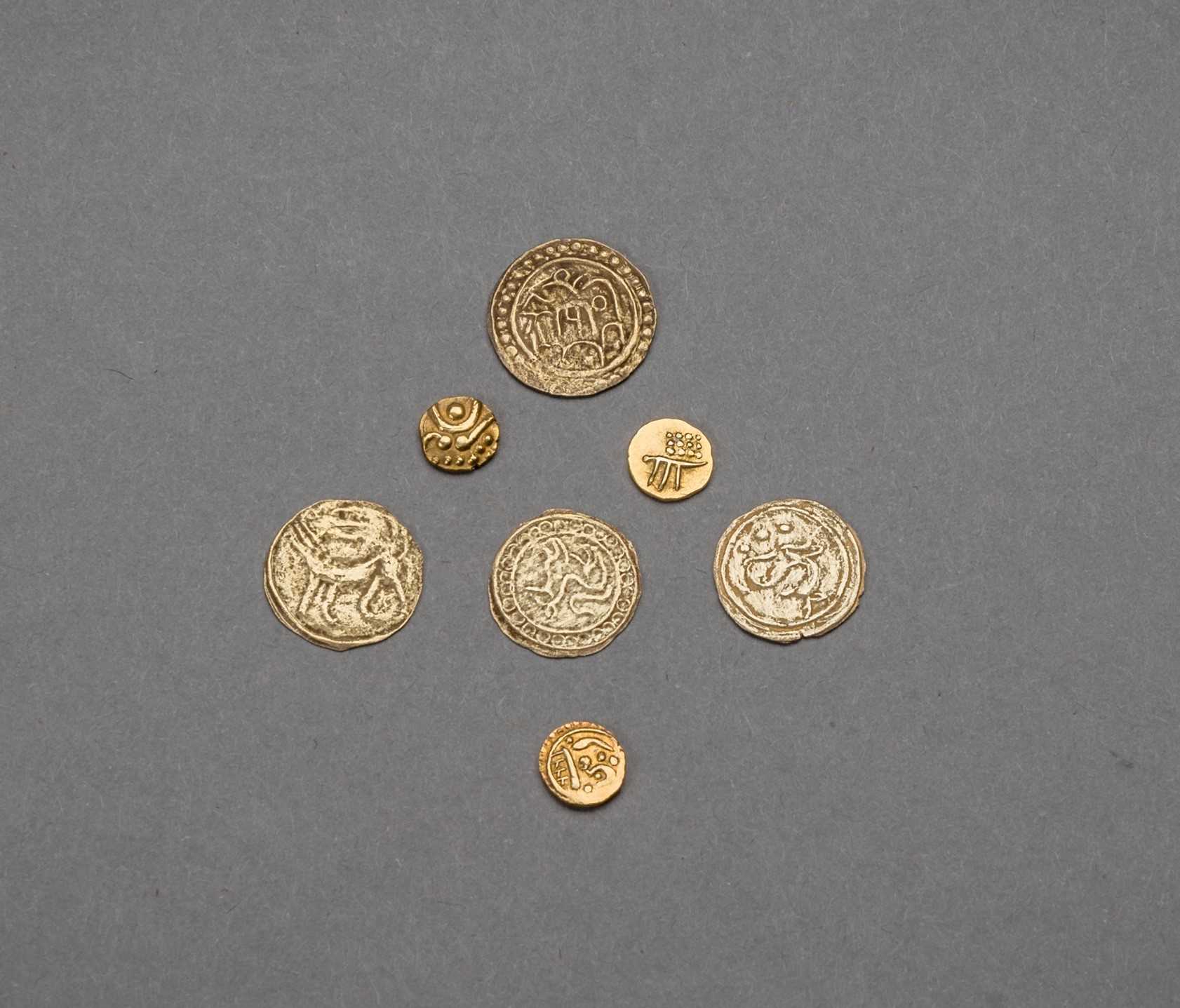
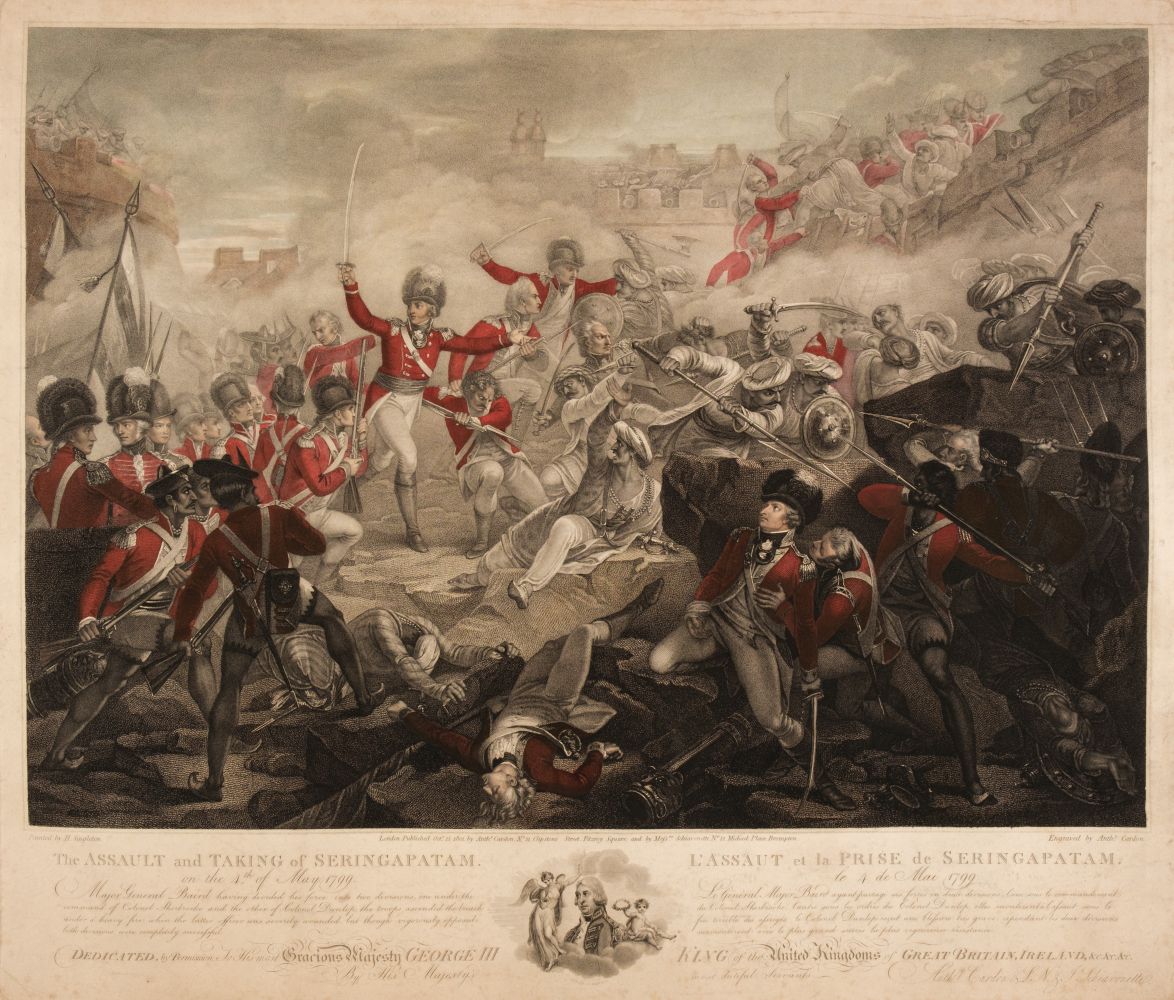


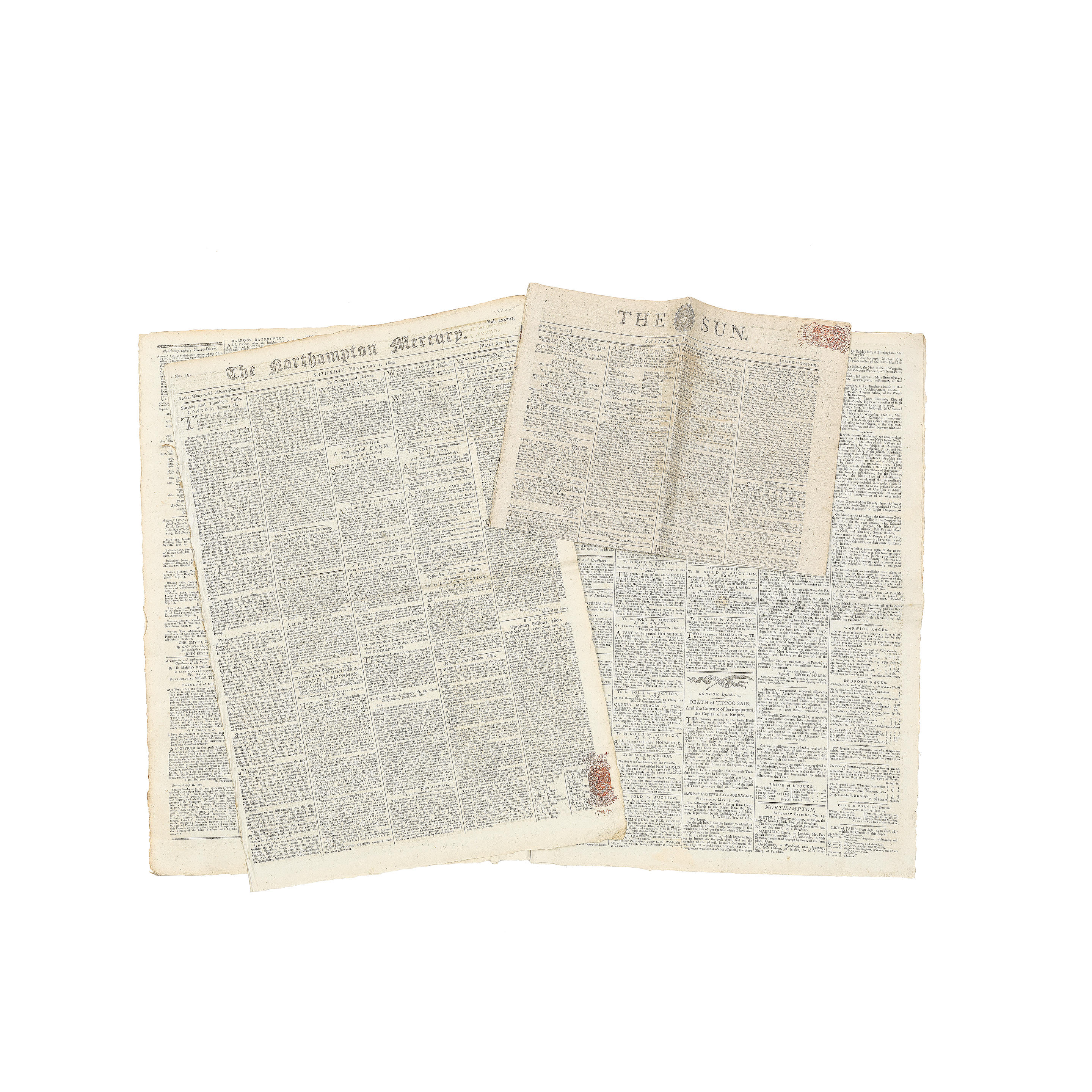
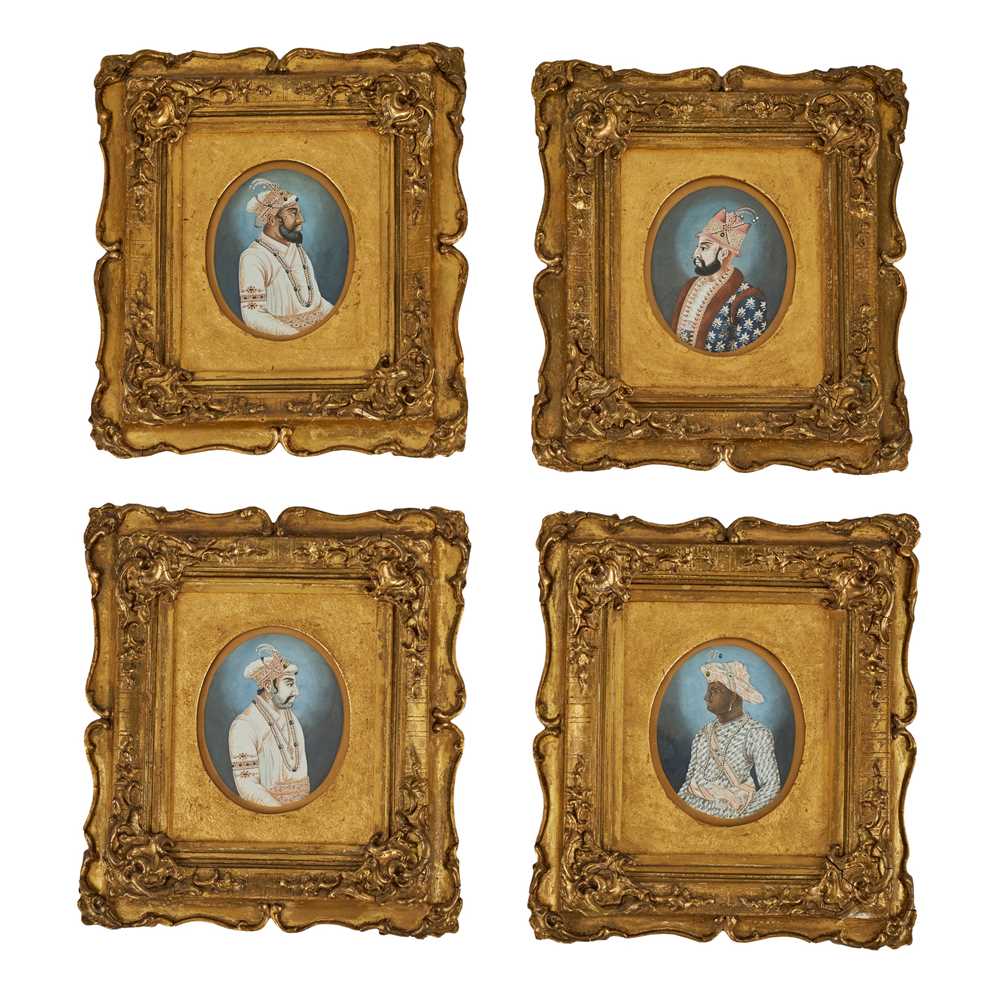
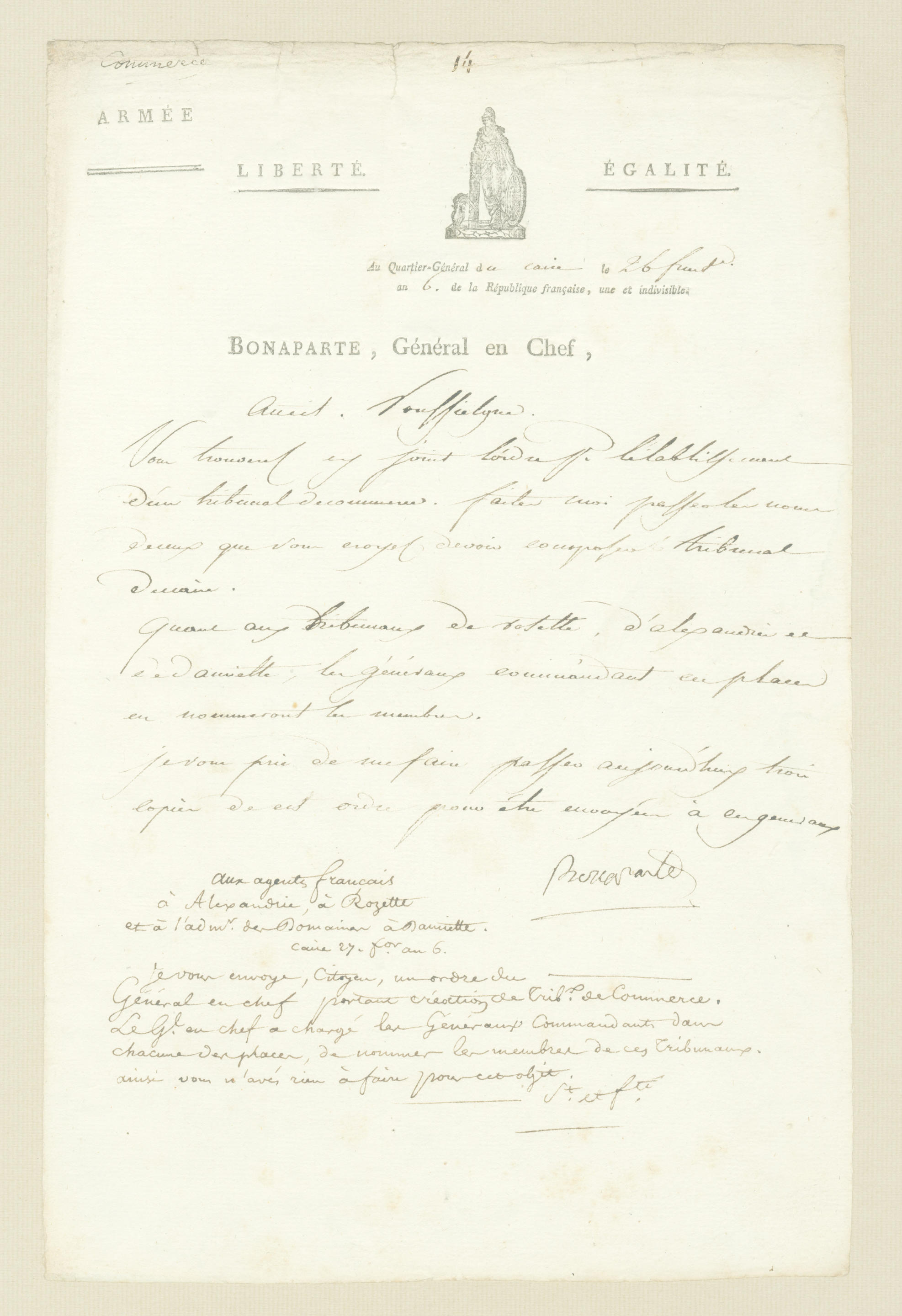
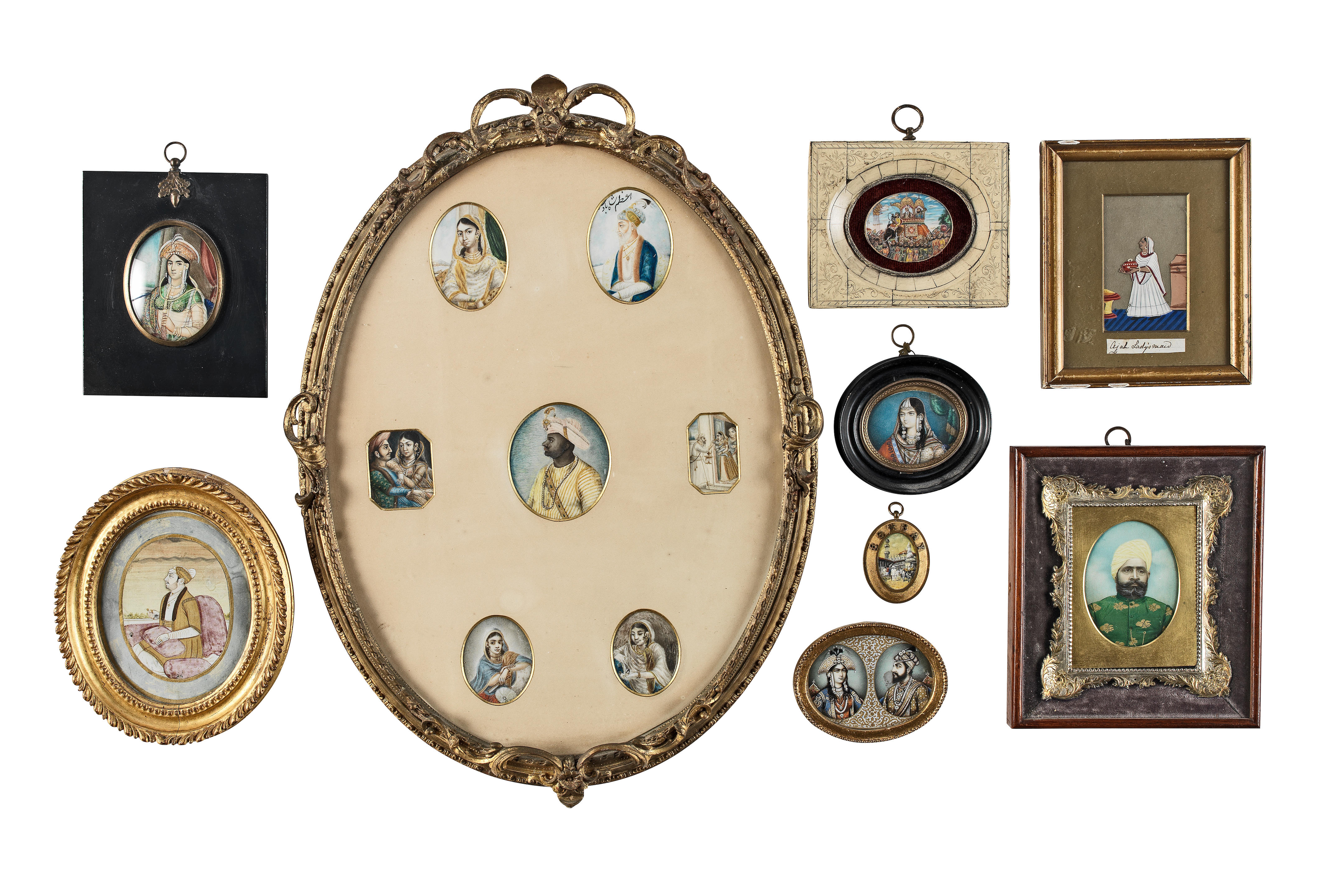
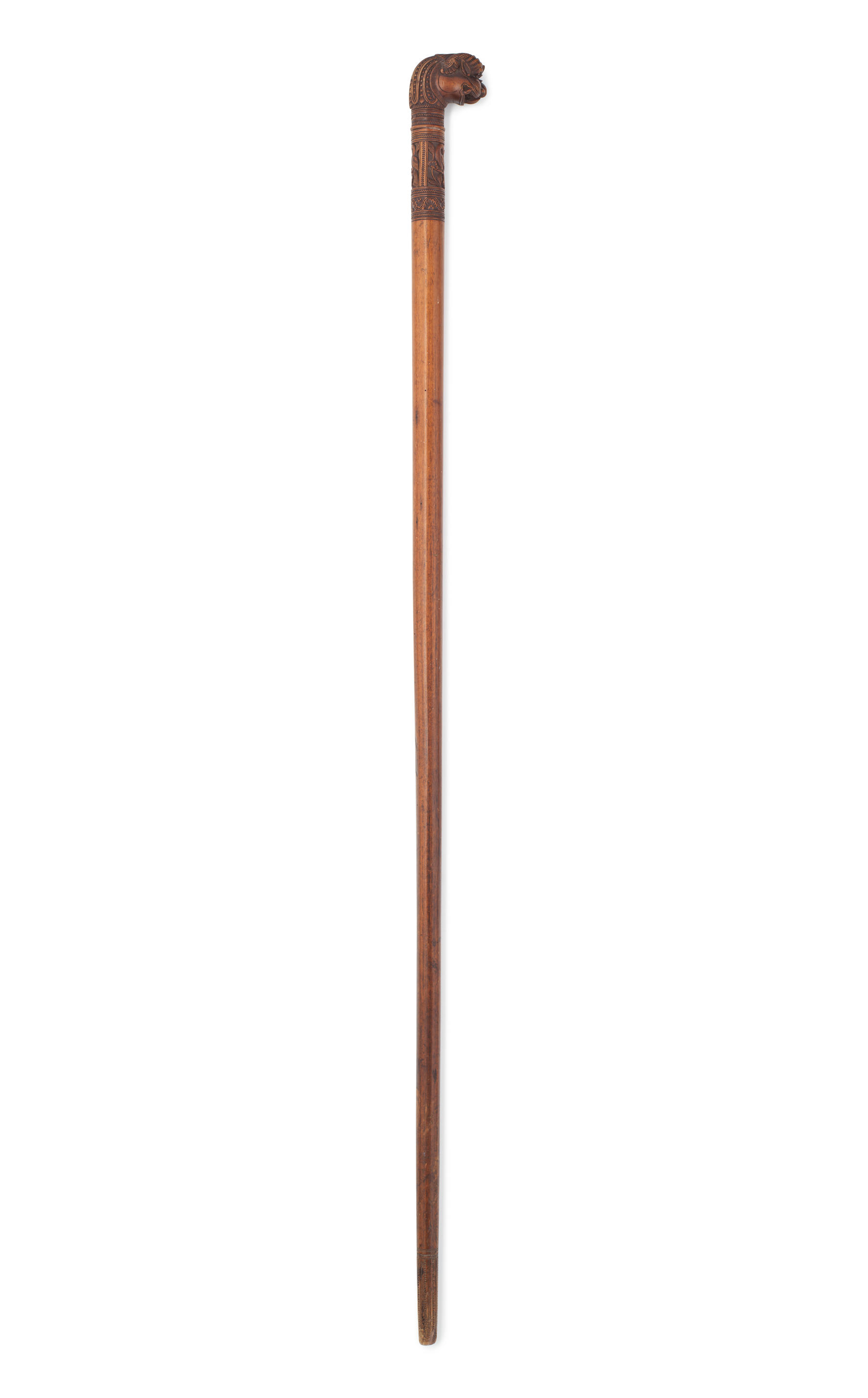
Try LotSearch and its premium features for 7 days - without any costs!
Be notified automatically about new items in upcoming auctions.
Create an alert